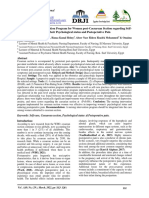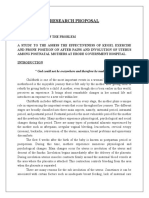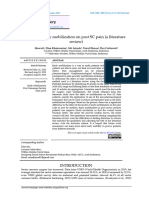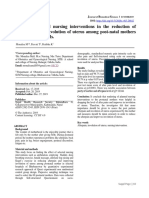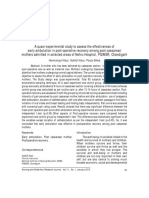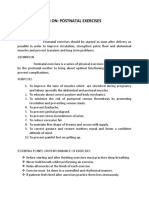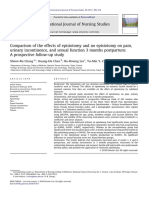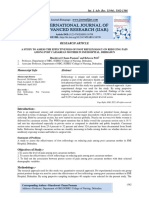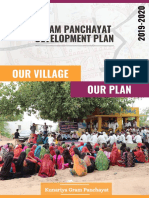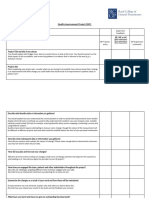N 19(2) S2: 104-109, 2024 www.thebioscan.
com
Save Nature to Survive
EFFECT OF SAMA VRITTI PRANAYAMA ON POST CAESAREAN SECTION
PAIN, STRESS AND LEVEL OF SATISFACTION AMONG POST PARTUM
MOTHERS AT PMCH & RI
Jeslin biniya, J 1, Esther sangeetha S2, Harsha 3 Poongodi Chellapandian4, Kavin Mozhi James5
Rajarajeshwari.v6 Ezhilrasi 7
1-3
B.Sc Nursing Iv yearstudent Panimalar College of Nursing, Varadharajapuram, Poonamallee
4 ,6,7
Panimalar College of Nursing, Varadharajapuram, Poonamallee, Department of obstetrics and gynaecology
5.
Panimalar College of Nursing, Varadharajapuram, Poonamallee, Department of Medical Surgical Nursing
DOI: https://doi.org/10.63001/tbs.2024.v19.i02.S2.pp 104-109
KEYWORDS ABSTRACT
Sama Vritti Pranayama or
Four square Breathing
Excercise,
AIM: This study aimed to evaluate the “Effect of four square breathing Exercise on Post caesarean Section Pain,
post caesarean section
pain, Stress and Level of Satisfaction” among Post-Partum Mothers .
stress and satisfaction
METHODS: A Quasi – experimental one group pre – test post – test research design was conducted with total of 60
Received on:
eligible and consented post caesarean section mothers selected for the study by purposive non probability sampling
05-06-2024 technique. The level of pain and stress was measured by Modified comfort behavioural pain scale, perceived stress
scale (PSS),self satisfaction rating scale (SSRS)
Accepted on: RESULTS: The major finding of the study revealed that “t” test value for pain is 10.676 and for stress is 16.0045 at the
level of p= 0.05. At the post test, (37) 62% of the post partum mothers are highly satisfied with the intervention. This
06-09-2024 study abides that four square breathing exercise is effective in reducing the level of post caesarean section pain and post
partum stress at the significance of p>0.05.
Corresponding author ETHICS AND DISSEMINATION: Ethical clearance was obtained from Institutional Human Ethics Committee
(PMCHRI-IHEC) on 12-12-2023. Protocol No: PMCHRI-IHEC-156
CONCLUSION: This study concluded that four –square breathing excercises significantly reduced the intensity of
post caesarean section pain ,stress as well as achieves a markable satisfaction rate among post caesarean mothers with
this intervention .
R E C O M M E N D A T I O N S : FOUR SQUARE breathing excercises should be incorporated into the nursing
intervention protocols to effectively improve the well-being of post partum mothers.
104
�INTRODUCTION
Among the several ways of delivery, Caesarean section is a stress and level of satisfaction among postpartum
surgical intervention to deliver the baby when normal delivery mothers
can increase the risk to mother as well as the baby. Worldwide, 2. Compare and analyze the post caesarean section pain,
number of babies getting delivered via caesarean section has stress and level of satisfaction among postpartum
nearly doubled in recent years. mothers.
As recommended by World Health Organisation (WHO), 3. Associate the participants demographic variable with
caesarean delivery should be between 10-15% of all the the level of post caesarean section pain and post
deliveries[1]. In India, caesarean section rates have been partum Stress
increasing from 10% to 30%, according to a recent analysis of
National Health and Family Survey (NFHS) 1992-93 to 2015- 1 METHODS and RESOURCES
16[2]. During postnatal period, woman undergoes a lot HYPOTHESES
physiological and psychological changes in her body. As H1 – At a significance level of P<0.05, there will be statistically
physiological changes occurs, the uterus begins to contract in significant differences and decrease in the post caesarean
order to retain its original structure. These persistent mild section pain in the post test among the post Partum mothers
contractions are known as after-labour pains or after-pains. The who have undergone caesarean section
after pains affects the body in such a way similar to traumatic H2 - At a significance level of P<0.05, there will be statistically
stress, which causes agony for the mother, especially significant differences and decrease in the post partum stress in
multiparous mother interfering with performing daily routine the post test among the post Partum mothers who have
activity of caring for herself and her baby. After-pains are undergone caesarean section
typically spasmodic in nature and is felt in the lower abdomen as H3 – Post caesarean mothers will report higher levels of
uterus contracts to retain its original form. However, initiation satisfaction in the post test with a statistically significant
of breastfeeding causes oxytocin to release from the posterior differences ( P<0.05)
pituitary gland, which leads to further uterine contractions. It H4 - There will be a significant association between the
may also trigger the neuro-hormonal stress response, which level of post caesarean section pain and post partum stress
further leads to anxiety, insomnia, and fatigue in postnatal Among post caesarean mothers with their selected demographic
mothers [3]. Variables.
Prolonged after pains not only affects the daily APPROACH
activities of the mother but also interferes with the mother –
child bonding and provide a worst postnatal experience to the This study adopted quantitative research approach
mother. Thus, it is crucial to manage the after pains effectively DESIGN
and enhance early relaxation of the uterus. This study included in Quasi – experimental one group pre - test
A caesarean section (CS) is a major surgery with an post – test research design.
estimated 18.5 million procedures being performed each year in
the world [4]. Therefore, the nurses’ role is to manage and VARIABLES
reduce patients’ postoperative pain effectively. Some Dependent Variable: Post – caesarean section pain and post
postoperative pain management can be conducted by nurses partum stress is the dependent variable of this study
independently including complementary therapy, music therapy, Independent Variable: Four square breathing exercise is the
cold application, and guided imagery. independent variable of this study
Post caesarean pain affects the body similar to traumatic stress
causing rise in pulse, blood pressure and tightness of muscles Demographic Variable age, religion, educational status,
Many studies done on after labour pain had assessed its nature occupation, type of work, monthly income, type of family,
and characteristics as well as non- pharmacological methods to residence and social support
minimize it. Non - pharmacological measures such as prone 4 SETTING OF THE STUDY
position, oil massage, Kegel’s exercise, deep breathing exercise This study was conducted in Panimalar Medical college
have been found useful in reducing post caesarean section pain. Hospital and Research Institute, Chennai, Obstetrical ward. This
Four-square breathing exercise, also known as box breathing, is is a NABH accredited hospital consisting of 720 beds with all
relatively a new technique of breathing exercise that can help in modern equipment and facilities. Out of these, 50 beds are
reducing after-labour pain in postnatal women. It is very simple occupied by the obstetrics cases included antenatal ward,
to learn and to practice as well as it can be practiced virtually postnatal ward and labour room separately.
anywhere and anytime. (Pamasamy& Suzan, 2014 &Scott, POPULATION
2020) The population of the study was post caesarean section
Four square breathing exercises are a non-pharmacological pain mother
reliever that has been shown to be beneficial in conditions other Target Population
than a Post caesarean section pain (Basyouni & Gohar, 2017). In Primiparous and Multiparous mothers admitted in
the present study, the investigator will use four-square breathing postnatal ward at PMCHRI
exercises. SAMPLE
Therefore, this study was carried out to investigate the effect of In this study, the sample was post caesarean mothers
four square breathing exercise in reducing post caesarean within 2 days (48 hours) of delivery
section pain which will actively improve daily routine activities
of postnatal mothers. The present study was conducted to SAMPLE SIZE
evaluate the impact of four square breathing exercise on level of The sample size for the study was 60 postpartum
pain and stress among post caesarean section mothers, which mothers who have undergone caesarean section and fulfill the
path out for quick adaptation to their new phase inclusion criteria.
Objectives: 8 SAMPLING TECHNIQUE
To assess the level of post caesarean section pain and Purposive non probability sampling technique was
post partum stress among postpartum mothers adopted for selecting the sample. Total of 60 post caesarean
1. To evaluate the effectiveness of four square breathing section mothers within 48 hours of delivery under the age group
exercise in post caesarean section pain, post Partum of 18 years to 35 years were selected for the study based on the
inclusion and exclusion criteria.
105
� mothers had experienced moderate pain and (15) 26% of the
3.9 CRITERIA FOR SAMPLE SELECTION post partum mothers had experienced mild pain and about (1) 1%
Inclusion Criteria of the post partum mothers had experienced no pain.
• Post caesarean section mothers, who have undergone In post test majority (28) 46% of post partum mothers had
caesarean section within 2 days, who were either experienced mild pain and about (26) 43% of the post partum
primigravida or multigravida, under the age group 18- mothers had experienced moderate pain and (6) 10% of the post
35 years. partum mothers had experienced no pain and about (1) 1% of the
• Free from any medical or obstetric risk factors. post partum mothers had experienced severe pain.
• Do not receive any pharmacological pain relief In pre test of post caesarean mothers (36) 60% of The mothers
substance. had experienced high level of stress, and about (14) 22% of The
• Delivered in the previous 24 hours, who had delivered mothers had experienced moderate level of stress, and about
full term, live single fetus (37 to 42 weeks) (10) 18% of The mothers had experienced low level of stress
respectively.
Exclusion Criteria In post test of post caesarean mothers (1) 1% of The mothers had
• Post caesarean section mothers, whose newborn had experienced high level of stress, and about (35) 59% of The
any congenital disorder or had a still birth or neonate mothers had experienced moderate level of stress, and about
died within few hours of delivery. (24) 40% of The mothers had experienced low level of stress
• Who were diagnosed to have any psychological illness respectively.
• Taking any other non pharmacological therapy for post The study implies that mild, moderate and severe post
caesarean section pain and stress relief, caesarean section pain and post partum stress is common among
the post caesarean mothers and the probability of no pain is
• Diagnosed to have any postnatal complication or
relatively very less than 1%. This study emphasis the importance
respiratory disorder will be excluded
of some innovative measures such as four square breathing
SAMPLE SIZE CALCULATION
exercise to reduce their post caesarean section pain and post
Sample size was calculated by the following formula:
partum stress.
According to data from literature (vasava et al., 2021) ,
COMPARISON BETWEEN THE PRE-TEST AND POST TEST
concerning level of significance of 5%, and power of study of
SCORES OF POST CAESAREAN SECTION PAIN
80%, the sample size
Table 4.3: Mean, standard deviation and mean percentage
N= [(Zα/2 + Zβ)2 × {2(SD)2}]
on post caesarean section pain in pre test and post test
(N = 60)
________________
(mean difference between the two groups)2
MAXIM PRE TEST POST TEST
GROUP UM
✓ zα/2: depends on 5% level of significance, SCORE S. MEA MEA MEA
MEAN S.D
which equals 1.96 D N% N N%
✓ zβ :depends on 80% power, which equals EXPERIME
0.84 . NTAL 26.01 8.5 6.1
40 31.8 15.3 23.3
✓ SD = standard deviation GROUP (n 66 2 11
= 60)
n= [(1.96 + 0.84)2 × {2(3.2)2 }]/ (1.7)2
n=55.6 The above table shows that the pre-test score was
So, the required sample number is 55 26.0166± 8.52 and mean percentage was 31.8 where as in post
test mean score was 15.3±6.111 and mean percentage was 23.3.
It reveals that four square breathing exercise was effective in
DISCUSSION reducing the post caesarean section pain.
COMPARISON BETWEEN THE PRE-TEST AND POST TEST
A quasi experimental study was done to evaluate the SCORE ON LEVEL OF STRESS
effectiveness of four square breathing exercise among post
caesarean section pain, stress and level of satisfaction among Table 4.4: Mean, standard deviation (sd) and mean
mothers at PMCH&RI, Chennai. The findings of the study have percentage of level of stress among post caesarean
been discussed with interference to the objective and relevant mothers in pre test and post test (N = 60)
study from the review of literature.
DESCRIPTION OF THE DEMOGRAPHIC VARIABLES
The researcher found that in post caesarean mothers according
PRE TEST POST TEST
to their age groups shows 38(63.3%) of them were in the age GROUP
MAXIMUM
group of 25 – 35 years, and the majority 32(53.3%) of them were SCORE MEAN MEAN
MEAN S.D MEAN S.D
Hindus , 21(35%) of them mothers are graduate, 33(63%) of the % %
mothers were unemployed, 42(72%) of the mothers were EXPERIMENTAL
sedentary worker, 41(28.3%) of them mothers had monthly GROUP (n = 40 26.216 10.064 24% 13.2 5.755 16%
income of Rs.20,000 – 25,000, 41(66.6%) of them mothers 60)
belongs to nuclear family, 22(51.6%) of them mothers were from
urban area, 50(83.3%) of them mothers had not undergone Yoga
classes, 56(93.3%) of them mothers had not undergone
Parenthood classes and 39(67%)of them post caesarean section
mothers had received Social Support from their mothers.
Objective – 1: To assess the level of post caesarean section
pain and stress among postpartum mothers in pre test and
post test
In pre test majority (26) 45% of post partum mothers had
experienced severe pain and about (18) 28% of the post partum
106
� The above table shows that in the pre test mean
Score was 26.216±10.064 and mean percentage 24%. Where
as in post test mean Score was 13.2 ±5.755 and mean
percentage was 16%.
of The mothers had experienced moderate level of stress, and
50 about (24) 40% of The mothers had experienced low level of
stress respectively.
40 Objective – 2: To evaluate the effectiveness of four square
30 breathing exercise in terms of level of pain, stress and level of
satisfaction among postpartum mothers
20 For the post caesarean section pain, the mean score
10 in pre test was 26.216 ± 8.52 and the mean score in post test is
0 15.3 ± 6.111. The ‘t ‘value is 10.676 which is significant at
P≤0.05 level. Thus it becomes evident that four square breathing
was effective in reducing the post caesarean section pain in post
test . Hence, H[1] is retained.
For post partum stress, the mean score in pre test was 26.216 ±
10.064 and the mean score in post test is13.2 ± 5.755. The ‘t
‘value is 16.0045 which is significant at P≤0.05 level. Thus, it
becomes evident that four square breathing was effective in
reducing the post partum stress in post test . Hence, H 2 is
retained.
Pre-Test Post-Test In post test of the intervention 37 (62%) of the post
caesarean section mothers had experienced high level of
satisfaction and about 17 (28%) of the post caesarean section
FIGURE 3.1 A percentage distribution of post caesarean pain
mothers had experienced moderate level of satisfaction, and
in pre-test and post test
about 6 (10%) of the mothers had experienced low level of
In pre test majority (26) 45% of post caesarean
satisfaction respectively. Hence, H3 is retained.
mothers had experienced severe pain and about (18) 28% of
The above findings, reveals that four square breathing
the post caesarean mothers had experienced moderate pain
exercise is effective in reducing post caesarean pain and post
and (15) 26% of the post caesarean mothers had
partum stress among post caesarean mothers. The post
experienced mild pain and about (1) 1% of the post
caesarean section mothers reports higher level of satisfaction in
caesarean mothers had experienced no pain.
the post test regarding the intervention.
In post test majority (28) 46% of post caesarean mothers had
Objective – 3: Compare and analyze the level of pain, stress
experienced mild pain and about (25) 43% of the post caesarean
and level of satisfaction between the pre test and post test.
mothers had experienced moderate pain and (6) 10% of the post
The mean, standard deviation and ‘t’ value between
caesarean mothers had experienced no pain and about (1) 1% of
the pre test and post test were compared and analyzed and the
the post caesarean mothers had experienced severe pain.
findings reveals that, there is a significant difference in the pre
test and post test. And the level of satisfaction was relatively
high in the post test.
Objective – 4: Associate the participants demographic variable
60 with the level of post caesarean section pain and post partum
stress
40 The present study reveals that, there was no
significant association between the level of post caesarean
section pain and post partum stress with their demographic
20 pre test variables at p≤0.05
RESULTS ; Based on the findings of the present study, it can be
0 post test concluded that four-square breathing exercise significantly
reduced intensity of after pains and reduced the frequency of
pain medication , enhanced early initiation of breast feeding as
well as achieved satisfaction of postpartum mothers with the
intervention. So, the study aim and hypothesis were achieved
within the framework of the present study.
Recommendations:
Based on the findings of the present study, the following
recommendations are suggested:
In-service training programs should be carried out for
postpartum health care providers to increase their
FIGURE 3.2 A percentage distribution of post partum stress in awareness about the positive effects of 4-square
pre test and post test breathing exercises in the management of after-labor pains and
enhance early initiation of breastfeeding as well as satisfaction
In pre test of post caesarean mothers (36) 60% of The - Four square breathing exercises is a practice that is
mothers had experienced high level of stress, and about (14) 22% inexpensive, effective, and easy to apply during
of The mothers had experienced moderate level of stress, and thehospitalization period. Therefore, it should be
about (10) 18% of The mothers had experienced low level of incorporated in the nursing intervention protocols of post-
stress respectively. partum mothers.
In post test of post caesarean mothers (1) 1% of The - The curriculum of basic nursing / midwifery education as
mothers had experienced high level of stress, and about (35) 59% well as continuing education should
107
�entail the four-square breathing exercises for management of and Childbirth, 21(1). https://doi.org/10.1186/s12884-020-
afterpains 03504-8
- Patient's education about Four square breathing exercises • Basyouni, D. N., &Gohar, D. I. (2017). Effect of breathing
should be implemented with all post- exercise on after pains among postpartum women. IOSR
partum women to help relieve pain Journal of Nursing and Health Science, 06(02), 88–96.
- A baseline information leaflet about the importance and the https://doi.org/10.9790/1959-0602068896
way of performing 4-square breathing exercises to manage • Buchholz, L. (2022, October 20). Anna Klepchukova,
after-labor pain, should be designed, and distributed to all revolutionising women’s Healthcare. March8.
postpartum women. https://march8.com/articles/anna-klepchukova-
- Future trials should aim to include larger sample sizes and revolutionising-womens-healthcare
different settings to justify the causal • Canada, P. H. A. of. (2023, December 13). Government of
association between the 4-square breathing exercises and Canada. Canada.ca. https://www.canada.ca/en/public-
after-labor pains. health/services/maternity-newborn-care-guidelines.html
- Further study should be performed to evaluate the effect of • Contributers , W. (2021). Box breathing: Getting started
using 4-square Breathing exercises for the management of pain with box breathing, how to do it, benefits and tips. WebMD.
following cesarean section https://www.webmd.com/balance/what-is-box-breathing
delivery • Dash, M. (2016). Effectiveness of selected nursing
interventions on after-pain among the postnatal mothers in
REFERENCES the Selected Hospital in Puducherry. International Journal
of Vaccines & Vaccination, 3(2).
https://doi.org/10.15406/ijvv.2016.03.00062
• Sexual and Reproductive Health and Research (SRH). (n.d.). • Elizabeth Scott, P. (2020, December 12). The benefits of
World Health Organization. box breathing for stress management. Verywell Mind.
https://www.who.int/teams/sexual-and-reproductive- https://www.verywellmind.com/the-benefits-and-steps-of-
health-and-research-(srh)/areas-of-work/maternal-and- box-breathing-4159900
perinatal-health/caesarean- • Fahey, J. O. (2017a). Best practices in management of
section#:~:text=14%20April%202015- postpartum pain. Journal of Perinatal & Neonatal
,WHO%20statement%20on%20caesarean%20section%20rates,t Nursing, 31(2), 126–136. https://doi.org/
hen%2C%20caesarean%20sections 10.1097/jpn.0000000000000241
• Mohan, V. N., Shirisha, P., Vaidyanathan, G., • Hayward, M. (1994). Pain: Clinical manual for nursing
&Muraleedharan, V. R. (2023). Variations in the prevalence practicepain: Clinical manual for nursing practice Margo
of caesarean section deliveries in India between 2016 and McCaffery Alexander Beebe Mosby Yearbook UK £17.25 0
2021 – an analysis of Tamil Nadu and Chhattisgarh. BMC 7234 1992 2. Nursing Standard, 9(11), 55–55.
Pregnancy and Childbirth, 23(1). https://doi.org/10.7748/ns.9.11.55.s69
https://doi.org/10.1186/s12884-023-05928-4 • HUNT, G. (2020). Family centred maternity and newborn
• Ahmed, A. H., Hassan, S. I., &Elsaba, H. a. H. F. (2022). care: national guidelines . Public health agency of canada.
Effect of Four-Square Breathing Exercise on After Pains, https://www.canada.ca/en/public-health/
Initiation of Breastfeeding, and Satisfaction with • Jafari, H., Courtois, I., Van den Bergh, O., Vlaeyen, J. W.
Intervention among Postpartum Mothers. Assiut Scientific S., & Van Diest, I. (2017). Pain and respiration: A systematic
Nursing Journal (Print), 10(29), 11–22. review. Pain, 158(6), 995–1006.
https://doi.org/10.21608/asnj.2022.120643.1319 https://doi.org/10.1097/j.pain.0000000000000865
• L. Gibbons, J. M. Belizán, J. A. Lauer, A. P.Betrán, M. • Jafari, H., Gholamrezaei, A., Franssen, M., Van Oudenhove,
Merialdi, and F. Althabe, “The Global Numbers and Costs of L., Aziz, Q., Van den Bergh, O., Vlaeyen, J. W. S., & Van
Additionally Needed and Unnecessary Caesarean Sections Diest, I. (2020). Can slow deep breathing reduce pain? An
Performed per Year: Overuse as a Barrier to Universal experimental study exploring mechanisms. The Journal of
Coverage World Health Report (2010) Background Paper, 30 Pain, 21(9–10), 1018–1030.
HEALTH SYSTEMS FINANCING,” World Heal. Rep., vol. 30, https://doi.org/10.1016/j.jpain.2019.12.010
2010. • Karlström, A., Nystedt, A., &Hildingsson, I. (2015). The
• WHO Statement on Caesarean SectionRates. (2015). PubMed meaning of a very positive birth experience: Focus groups
Central. https://doi.org/10.1111/1471-0528.13526 discussions with women. BMC Pregnancy and Childbirth,
• Why C – section deliveries are rising at an alarming rate in 15(1). https://doi.org/10.1186/s12884-015-0683-0
India. (2023b, March 8). Deccan Herald. • Krasowski, J. A. (2020). Breath, the new science of a lost
https://www.deccanherald.com/india/why-c-section- art. CRANIO®, 38(6), 419–419.
deliveries-are-rising-at-an-alarming-rate-in-india- https://doi.org/10.1080/08869634.2020.1823793
1196909.html • Lalhriatpuii, L. (2021). Assessment of the effectiveness of
• Mohan, V. N., Shirisha, P., Vaidyanathan, G., patterned breathing technique in reduction of pain during
&Muraleedharan, V. R. (2023b). Variations in the first stage of labour among Primigravida mothers.
prevalence of caesarean section deliveries in India between Bioscience Biotechnology Research Communications, 14(9),
2016 and 2021 – an analysis of Tamil Nadu and Chhattisgarh. 262–267. https://doi.org/10.21786/bbrc/14.9.49
BMC Pregnancy and Childbirth, 23(1). • Moore, E. R., Bergman, N., Anderson, G. C., & Medley, N.
https://doi.org/10.1186/s12884-023-05928-4 (2016). Early skin-to-skin contact for mothers and their
healthy newborn infants. Cochrane Database of Systematic
• Didyala, A. (2023, April 27). Telangana’s “Muhurat” births Reviews, 2016(11).
propel C – section rate to national high. THE TIMES OF https://doi.org/10.1002/14651858.cd003519.pub4
INDIA. • Panda, S., Das, A., Mallik, A., & Ray Baruah, S. (2021).
https://timesofindia.indiatimes.com/city/hyderabad/muhu Normal puerperium. Empowering Midwives and Obstetric
rat-births-propel-c-section-rate-to-national- Nurses. https://doi.org/ 10.5772/intechopen.96348
high/articleshow/99771334.cms • Stinson, A. (2018). Box breathing: How to do it, benefits,
• Asadi, M., Noroozi, M., &Alavi, M. (2021). Exploring the and tips. Medical News Today.
experiences related to postpartum changes: Perspectives of https://www.medicalnewstoday.com/articles/321805
mothers and healthcare providers in Iran. BMC Pregnancy • Tawil, S., Iskandar, K., &Salameh, P. (2018). Pain
management in hospitals: Patients’ satisfaction and related
108
� barriers. Pharmacy Practice, 16(3), 1268.
https://doi.org/10.18549/pharmpract.2018.03.1268
• Vasava, J., Patel, S., & Tiwari, A. (2021). Effectiveness of
four-square breathing exercise on after-labour pain among
post-natal mothers. Indian Journal of Continuing Nursing
Education, 22(1), 35.
https://doi.org/10.4103/ijcn.ijcn_16_19
• Wisner, K. (2022). Postpartum pain management. MCN: The
American Journal of Maternal/Child Nursing, 47(1), 52–52.
https://doi.org/10.1097/nmc. 0000000000000774
• World Health Organization. (n.d.). Maternal and perinatal
health. World Health Organization.
https://www.who.int/teams/sexual-and-reproductive-
health-and-research-(srh)/areas-of-work/maternal-and-
perinatal-health
• ŞAHİN, O., & KOCAMAZ, D. (2021). Effects of diaphragmatic
mobilization and diaphragmatic breathing exercises on pain
and quality of life in individuals with shoulder pain: A
randomized controlled trial. International Journal of
Disabilities Sports and Health Sciences, 4(2), 113–123.
https://doi.org/10.33438/ijdshs.976285
109









